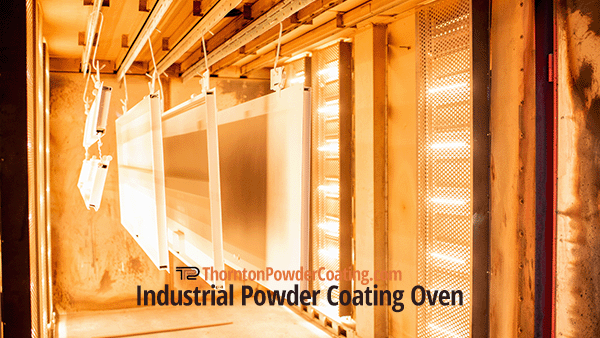Frequently Asked Questions about Industrial Powder Coating
Updated March 16, 2023
Do you do sandblasting?
No, we do not.
Curing Process
The curing process for powder-coated surfaces typically involves baking the material at a high temperature to ensure that the coating is cured and adhered to the surface. The curing time depends on many factors, including the type of powder used, the thickness of the coating, and the specific curing temperature. Typically, temperatures range from 350°F to 400°F. After baking, the coated surface should be allowed to cool before use. This helps ensure that it has achieved optimal bonding and hardness.

What materials are suitable for powder coating?
Powder coating is suitable for a variety of materials, including metal, wood, and plastic. At Thornton Powder Coating, we ONLY work with metals and aluminum. Metal surfaces are most commonly powder coated, as the coating forms a powerful bond with the substrate. Wood and plastic can also be powder coated but may require additional steps, such as a primer or sealant before application.
Adhesion Techniques
Adhesion techniques in powder coating refer to the methods used to ensure that the powder particles properly adhere to the substrate. One of the most common techniques is high-temperature curing, which involves baking the substrate and powder at very high temperatures. This process helps create a strong bond between the two materials. Other adhesion techniques include chemical and/or mechanical bonding, which involves using an adhesive or force to attach the powder particles to the coated surface.
Faster Oven Speeds
Faster oven speeds in powder coating refer to the increased rate or speed at which the oven heats up during curing. Higher oven speeds can help create a stronger bond between the powder particles and substrate, resulting in superior adhesion and a uniform surface finish. Faster oven speeds can also reduce cycle time and lead to improved efficiency in the powder coating process.
Automated Spray Systems
Automated spray systems are used in powder coating to deliver a uniform and consistent application of the powder particles across the surface being coated. An automated system is typically composed of multiple components, such as an electrostatic gun, powder feed conveyor, and hopper. This system helps improve the coverage and quality of the finish by ensuring that all areas are covered.
Improved Application Techniques
Improved application techniques for powder coating refer to the methods used to ensure that the powder particles are evenly distributed and properly adhered to the substrate.
- One of the most common techniques is electrostatic spraying, which involves using an electric charge to attract the powder particles to the surface being coated.
- Other improved application techniques include fluidized beds and tribostatic spray coating, both of which use air pressure and airflow to achieve uniform particle distribution.
- Manual brushing and roll-on methods can also be used in certain situations.
Volatile Organic Compounds VOC’s
Volatile organic compounds (VOCs) are organic chemical compounds that easily evaporate at room temperature. VOCs can be hazardous to human health and the environment. They are often found in paints and solvents and contribute to air pollution through emissions from everyday products such as household cleaning supplies and aerosol sprays. VOCs can cause a number of respiratory issues, headaches, nausea, eye and throat irritation, allergic reactions, and other serious health problems. In order to reduce VOC exposure and conserve the environment, many manufacturers have started using powder coatings instead of traditional liquid paints.
What is a Substrate?
A substrate is a material onto which a coating is applied. It can be any surface, such as metal, wood, plastic, etc. The substrate must be properly prepared before it is coated to ensure that the coating adheres correctly and doesn’t flake off over time. Substrates can also be treated with primers or sealers that help the coating stick better and last longer.
